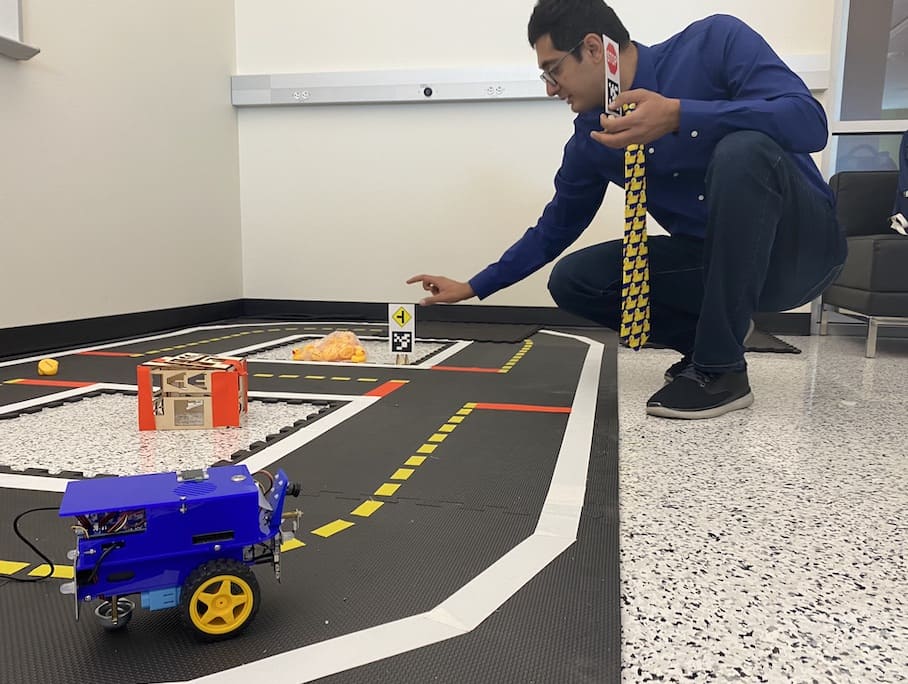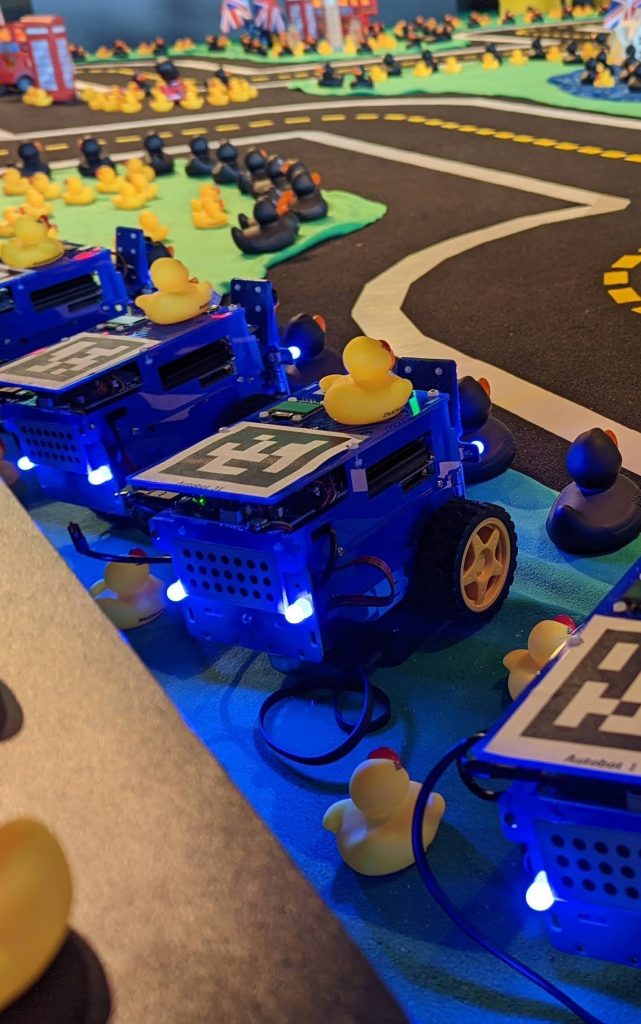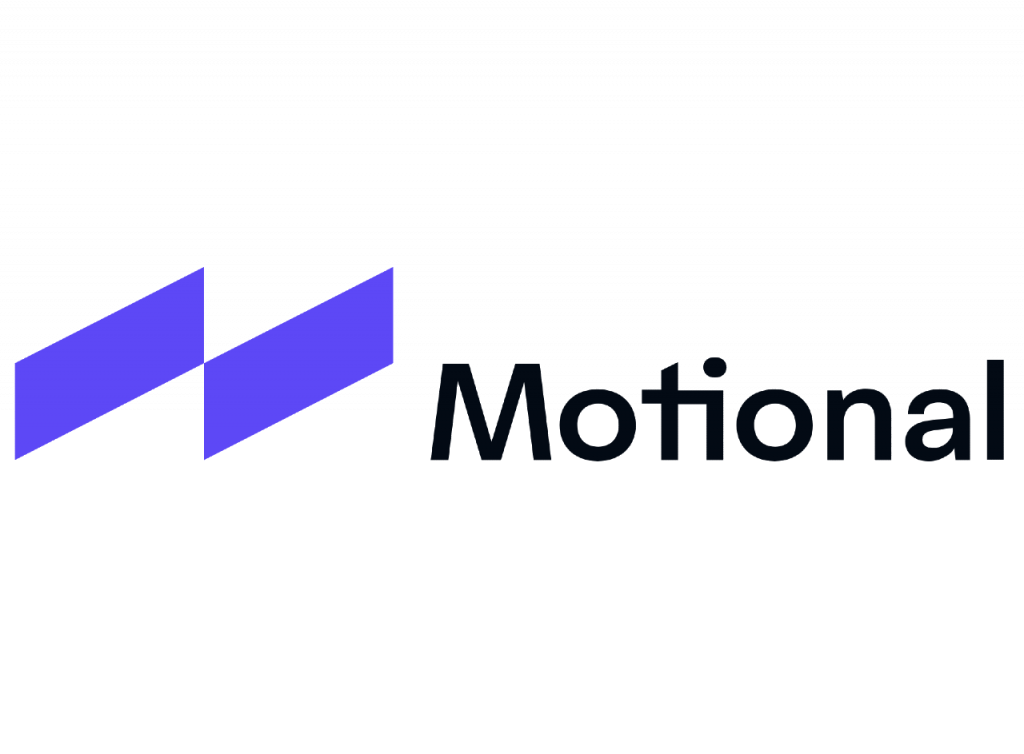
Category: Post categories


Introduction to robotics at the University of Massachusetts Lowell using Duckietown
University of Massachusetts, Lowell, December 20, 2022: Paul Robinette, Assistant Professor at the University of Massachusetts Lowell (UML), shares with us his Duckietown teaching experience.
Introduction to robotics at the University of Massachusetts Lowell using Duckietown
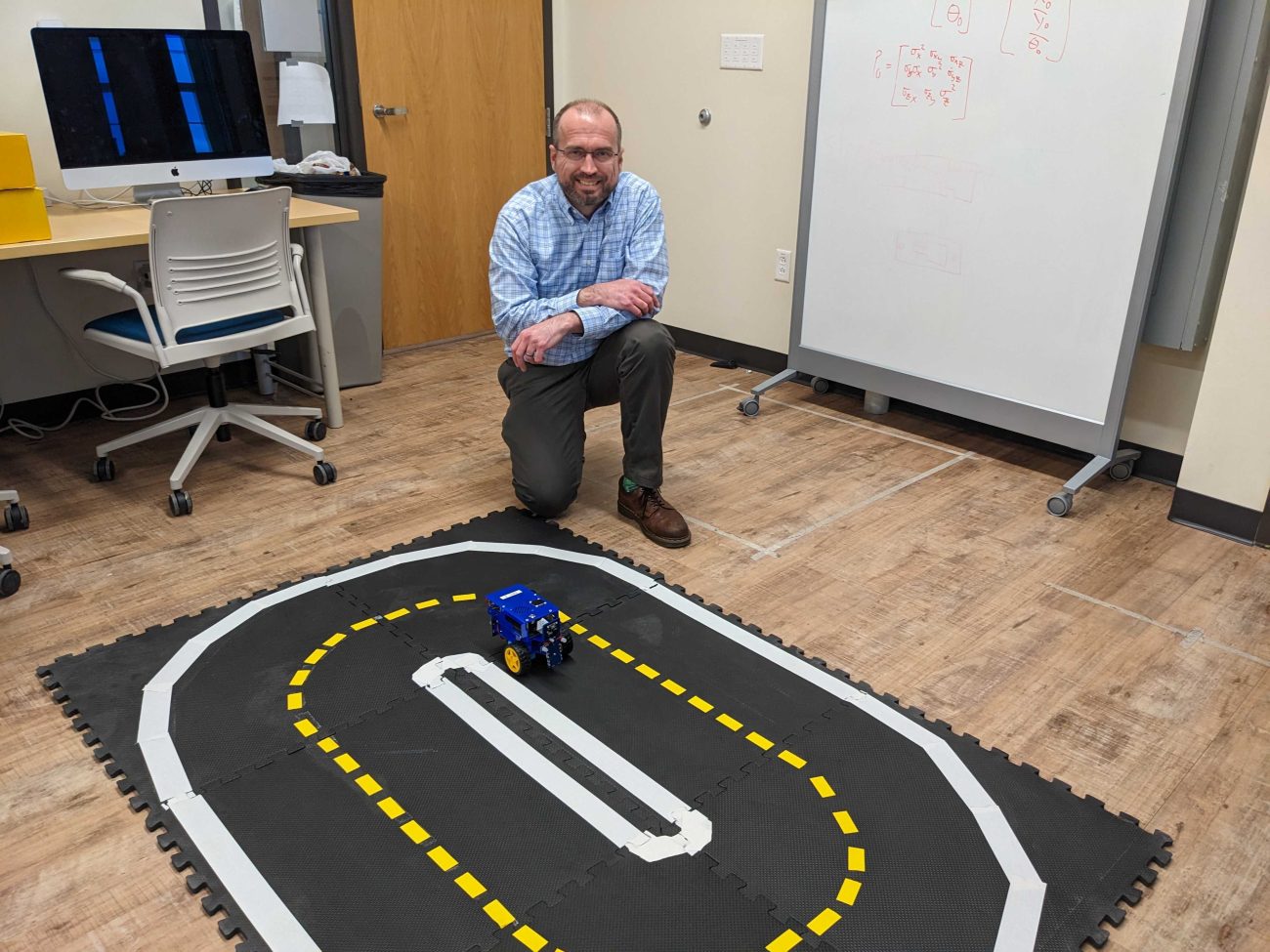
Thank you for finding the time to talk with us! Could you introduce yourself?
My name is Paul Robinette [Linkedin] and I’m a Professor of computer engineering at the University of Massachusetts Lowell [website].
When was your first experience with Duckietown?
My first experience with Duckietown would have been when I worked at MIT as a research scientist, just after Duckietown was run. I didn’t have a chance to see it live there, but I did talk with several of the postdocs who worked on it as it ran. I also saw it live for the first time at ICRA 2019.
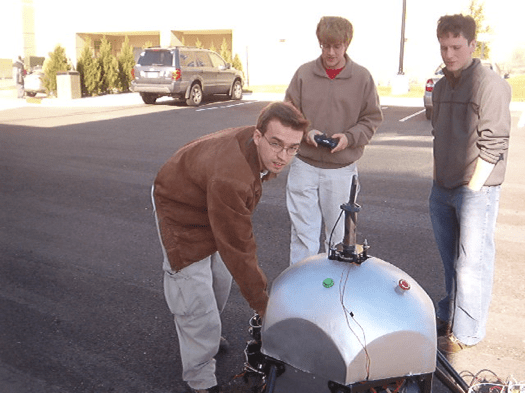
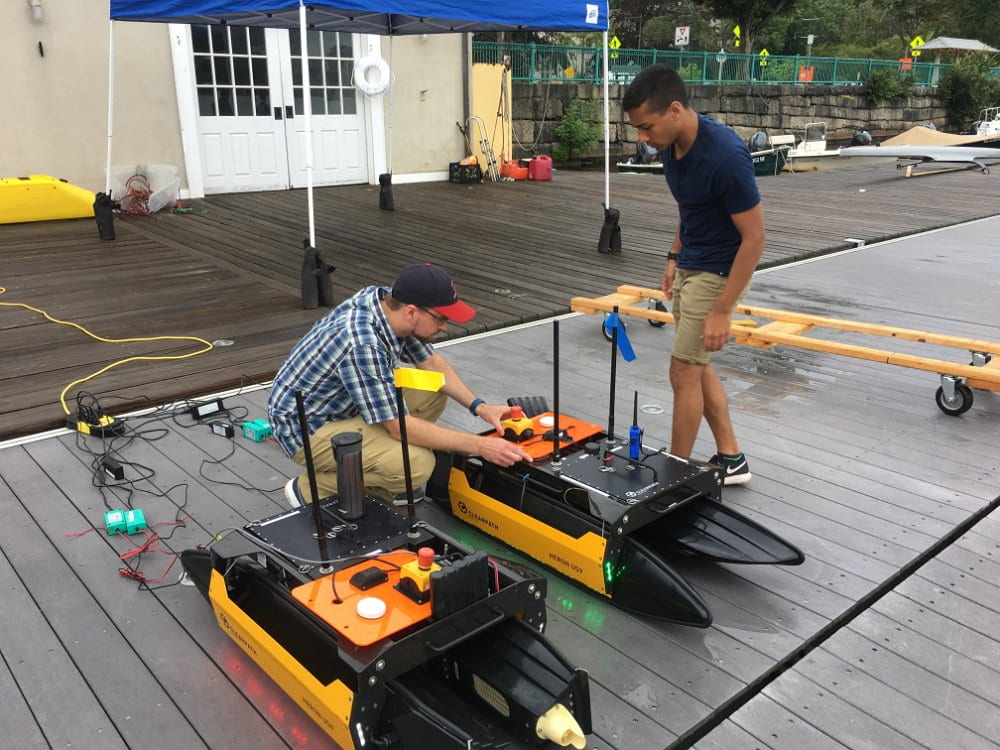
Do you use Duckietown or did you use Duckietown in the past for some specific project or activity?
Sure! For the last three years, I’ve been using Duckietown robots in my class every semester. Primarily I use the Duckiebots to teach ROS and basic robot skills through the Duckietown system and infrastructure. I leverage the development infrastructure heavily and some of the course materials as well.
That sounds great! Can you tell us more about your ongoing class?
The class I teach every semester so far is called Fundamentals of Robotics [2022 class page], and we go over the basics of robotics, starting with multi-agent processing or multi-process systems, like most robots are these days, some basic networking problems, etc. The Duckiebots are perfect for that because they have Docker containers on board which have multiple different networks running. They have to work with the computer system, so it’s always at least interfacing with the laptop. The robots can be used with a laptop, with a router, you can have multiple robots out at once, and they give the students a really good sense of what moving real robots around feels like. We have students start by implementing some open loop control systems, then have them design their own lane detector, similar to the Duckietown [perception] demo, and then have them design their own lane controller again, similar to the Duckietown [lane following] demo.
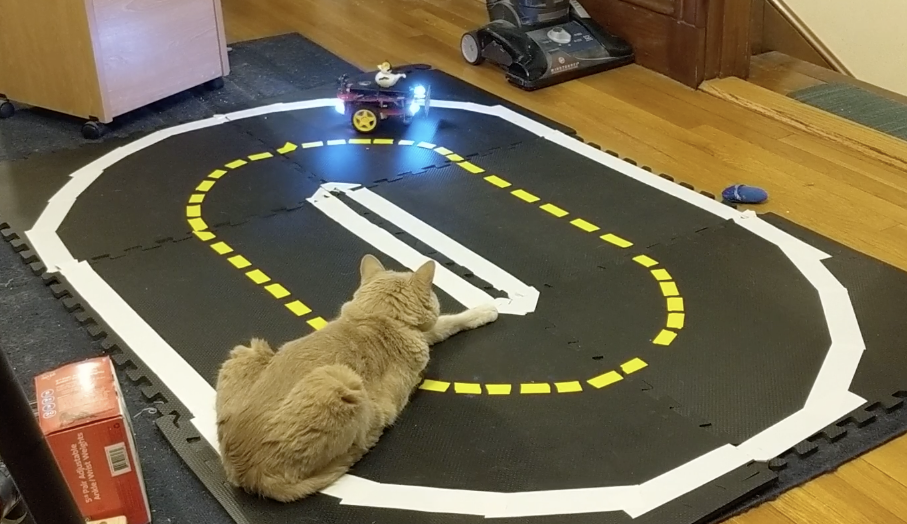
Are your students appreciating using Duckietown? Would you consider it a success?
Yes, especially the newer version. The DB21s are great robots for using their class applications and infrastructure. The software infrastructure has made it pretty easy to set up our own Git repositories for the robots and be able to run them. In this way, students can run them at home or on campus.
Would you suggest Duckietown to your students or colleagues?
Yes, I’d suggest Duckietown, especially if people want to run an introductory robotics class and have every student purchase their own robot, or have the University provide the robots for all. Duckietown is much more affordable than any other robot system that could be used for this same purpose.
"In my class we go over the basics of robotics, starting with multi-agent processing or multi-process systems, like most robots are these days, and the Duckiebots are perfect for that"
Prof. Paul Robinette
It is great to hear Duckietown addresses your needs so well. What would you say is the advantage that Duckietown has when compared to other systems?
I’d say the expense is probably the biggest advantage right now. It’s a nice platform and very capable for what we wanted to do. At this point, the fact that it’s affordable for students to purchase on their own or for us to purchase a bunch of them is definitely the biggest advantage for us. You guys also have a really quick response time if we have any problems. It’s nice to be able to talk directly with the development team and work with them to set up the systems so that I can run them in my class as I need to.
Thank you very much for your time!
Learn more about Duckietown
The Duckietown platform enables state-of-the-art robotics and AI learning experiences.
It is designed to teach, learn, and do research: from exploring the fundamentals of computer science and automation to pushing the boundaries of knowledge.
Tell us your story
Are you an instructor, learner, researcher or professional with a Duckietown story to tell? Reach out to us!
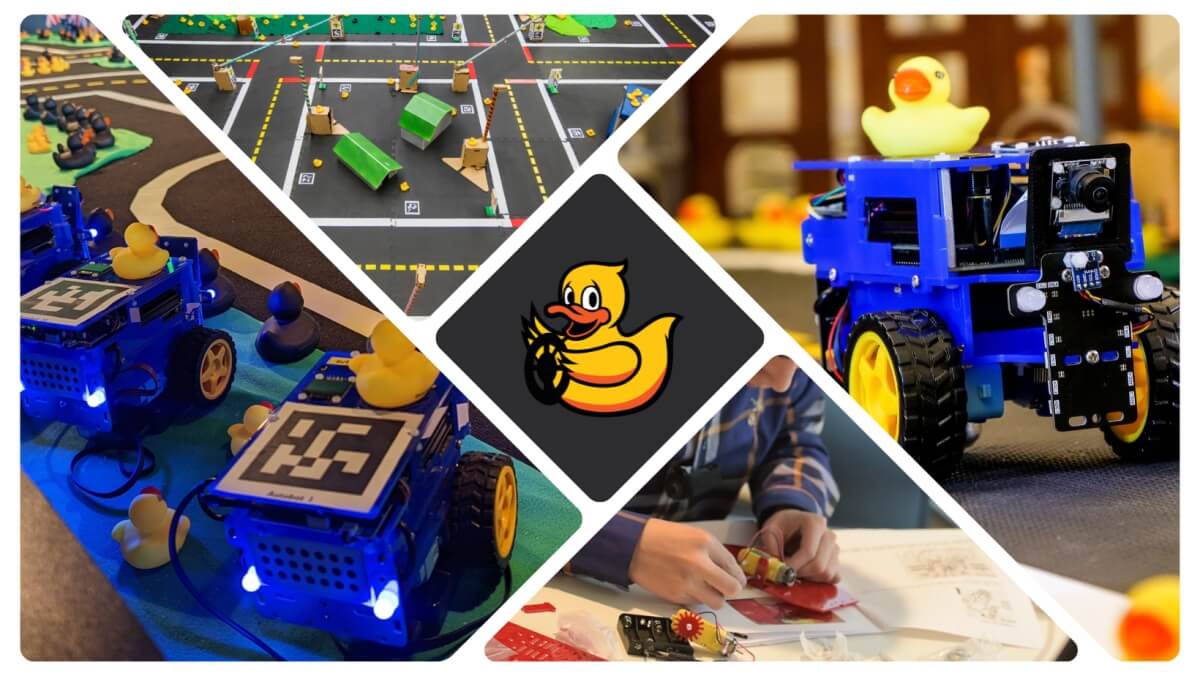
Join the new “Self-Driving Cars with Duckietown” MOOC
Join the self-driving cars with Duckietown MOOC user-paced edition
Over 7200 learners engaged in a robotics and AI learning adventure with “Self-Driving Cars with Duckietown”, the first massive online open course (MOOC) on robot autonomy with hardware, hosted on the edX platform.
Kicking off on November 29th, this new edition is a user-paced course with rich and engaging modules offering a grand tour of real-world robotics, from computer vision to perception, planning, modeling, control, and machine learning, released all at once!
With simulation and real-world learning activities, learners can touch with hand the emergence of autonomy in their robotic agents with approaches of increasing complexity, from Brateinberg vehicles to deep learning applications.
We are thrilled to welcome you to the start of the second edition of Self-Driving Cars with Duckietown.
This is a new learning experience in many different ways, for both you and us. While the course is self-paced, the instructors and staff, as well as your peer learners and the community of those that came before you are standing behind, ready to intervene and support your efforts at any time.
Learn autonomy hands-on by making real robots take their own decisions and accomplish broadly defined tasks. Step by step from the theory, to the implementation, to the deployment in simulation as well as on Duckiebots.
Leverage the power of the NVIDIA Jetson Nano-powered Duckiebot to see your algorithms come to life!
MOOC Factsheet
- Name: Self-driving cars with Duckietown
- Platform: edX
- Cost: free to attend
- Instructors: Swiss Federal Institute of Technology in Zurich (ETHZ), Université de Montréal (UdM), Toyota Technological Institute at Chicago (TTIC)
Prerequisites
- Basic Linux, Python, Git
- Elements of linear algebra, probability, calculus
- Elements of kinematics, dynamics
- Computer with native Ubuntu installation
- Broadband internet connection
What you will learn
- Computer Vision
- Robot operations
- Object Detection
- Onboard localization
- Robot Control
- Planning
- Reinforcement Learning
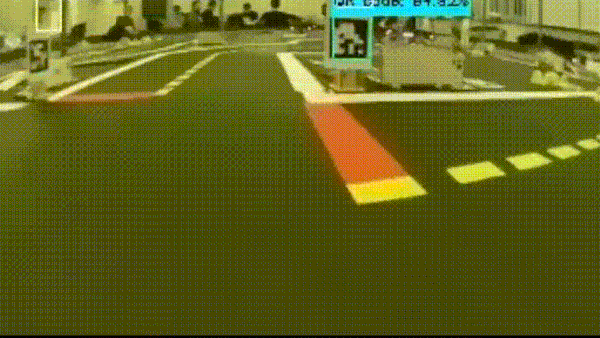
The Duckietown robotic ecosystem was created at the MIT Computer Science and Artificial Intelligence Laboratory (CSAIL) in 2016 and is now used in over 175 universities worldwide.
“The Duckietown educational platform provides a hands-on, scaled-down, accessible version of real-world autonomous systems.” said Emilio Frazzoli, Professor of Dynamic Systems and Control, ETH Zurich, “Integrating NVIDIA’s Jetson Nano power in Duckietown enables unprecedented access to state-of-the-art compute solutions for learning autonomy.”



Enroll now and don’t miss the chance to join in the first vehicle autonomy MOOC with hands-on learning!


The Duckietown path to robotics: an interview with Prof. Francesco Maurelli
Jacobs University, Bremen, June 1, 2022: Francesco Maurelli, professor at the Jacobs University of Bremen, talks about how Duckietown impacted his work and his academic career.
The Duckietown path to robotics: an interview with Prof. Francesco Maurelli
Francesco Maurelli, professor at the Jacobs University of Bremen, Germany, shares in the interview below his interaction with Duckietown.
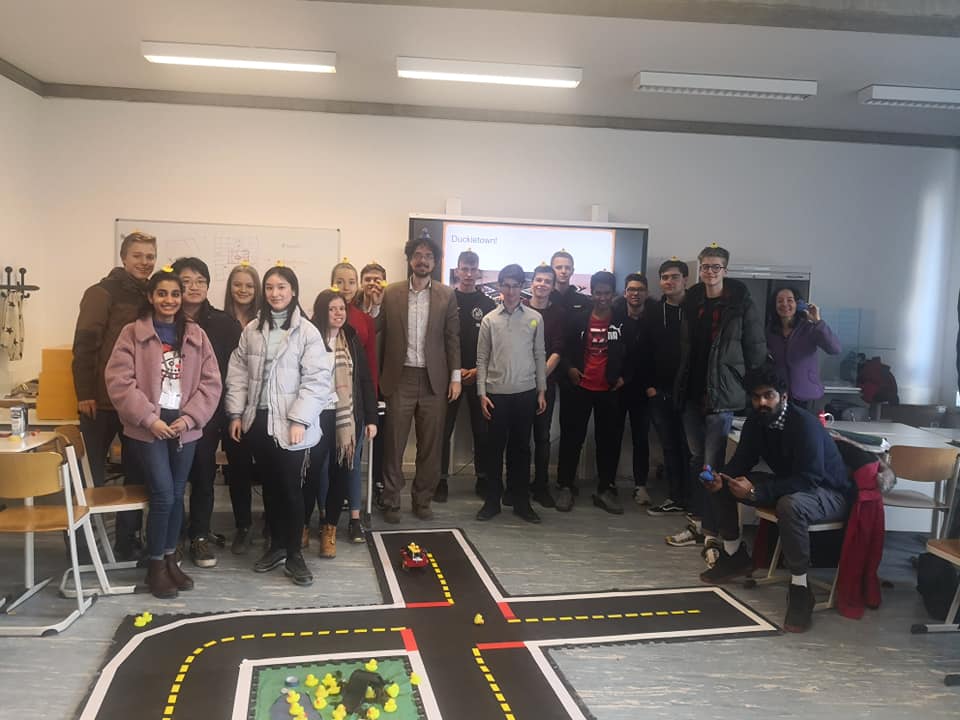
Let’s start by simply asking your name, who you are, where you work, what you do for a living.
Hi, Federico. Hi, everyone. I am Francesco Maurelli and I’m a professor in robotics at Jacobs University in Bremen.
When was the first time you came across Duckietown in your life? Describe your first contact with Duckietown for us.
Well, that was in my team. I was there as a Marie Curie scholar from Europe. I met Andrea and Liam, and learned about this new initiative. I was interested so I spoke in depth with them and with the students who took the course. I then looked at the videos and thought it was a great setup because it brings robotics closer to the students in a fun way by reducing the access barrier. Many people think that robotics is very hard, which is true. I’m not saying it’s easy, but on the other hand, there are easier paths to access robotics. Additionally the element of gamification makes people happy when they work with Duckietown. I found that students want to get involved regardless of the course work, they just like the concept.
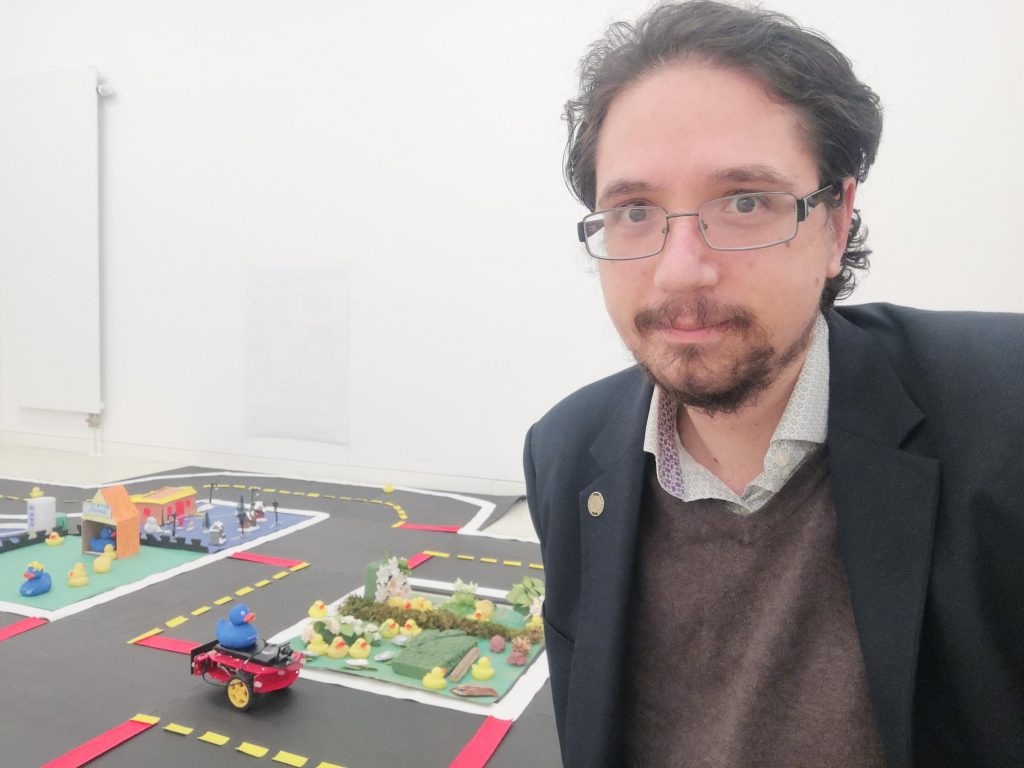

Thank you. Is there a specific thing that maybe you did using Duckietown in your life, a project, a program or some sort of ecosystem?
We have had three different initiatives based on Duckietown.
The first one, called Jacobs Robotics, was an extracurricular activity for students. I would meet interested students outside of class time, it wasn’t linked to academic credit. It was just for fun and for learning. Among the different robotics platforms, we had a group working on Duckietown. This was the initial step in using Duckietown at our university.
Then the second step was to embed Duckietown in the official curriculum. We have a bachelor’s program in robotics and intelligence systems, and I’m its program manager. We were rewriting and updating some parts of it as we underwent a new wave of accreditation. So I took the opportunity to redesign some aspects of the program and in this process decided to embed Duckietown at Bachelor level. I’ve introduced it at Ross Lab in simulation in the fall of the second year, in the third semester, and then we have a robotics project based on Duckietown in the spring, ofthe second year, (i.e. in the fourth semester). That means that when students start their third year, they already have an understanding of ROS, they have knowledge of Duckietown and they work with real systems. This means that they can do a much better thesis, even if it’s a Bachelor level, we can improve the average level. When I joined the University, the first month of the thesis was lost on students learning to use Ross, for example. Now we are a step ahead.
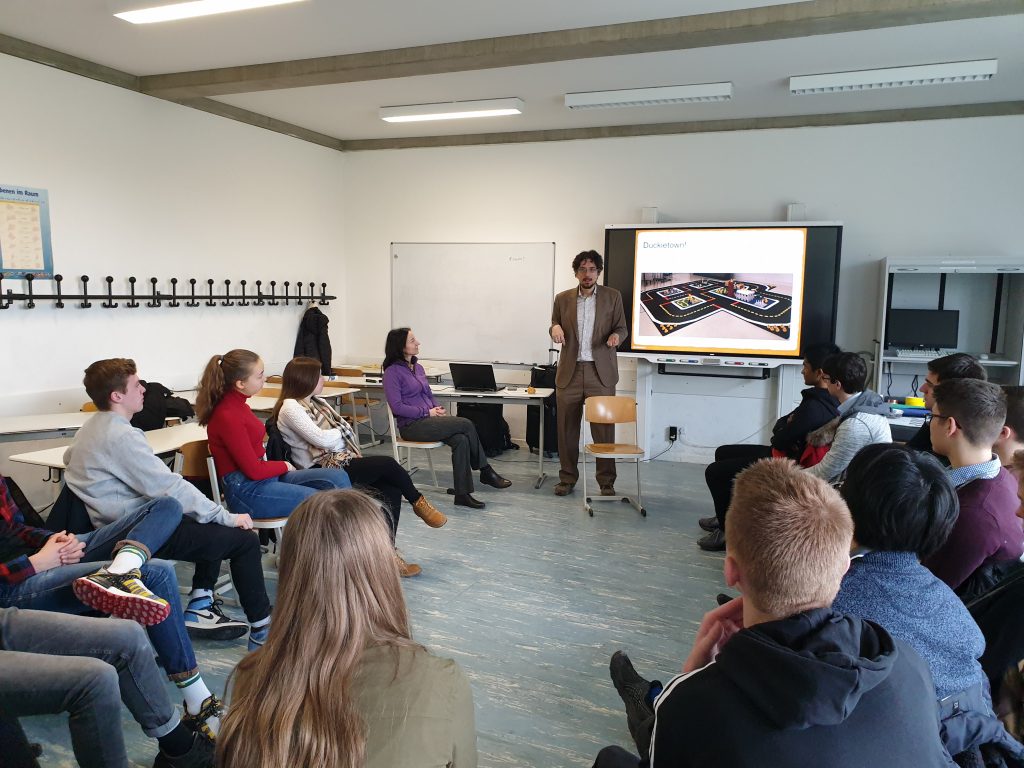
The third part is the research application. It’s not only a matter of having fun with students, or delivering courses to students, but also doing my own research. I have a project which is funded by the German Research Foundation, DFG, it is in collaboration with the psychology Department. The psychologists want to look at the characteristics that humans assign to entities to identify the “self”. We as roboticists are going to develop and program different robotic behaviors, which the behavioral scientist from the psychology department will analyze. In a nutshell, we will prepare different videos illustrating the same actions performed in different ways. A very basic example would be moving in a city at constant speed or moving in a city at variable speeds. Our partners in the psychology department will show these videos to the study participants and collect user feedback through questionnaires to determine which behaviors they think are more alike a self determined behavior.
This is extremely interesting. Thank you very much. Have you ever heard about the MOOC course?
Yes, actually. In fact I suggested to our students to look at the MOOC. Of course, it is set up in a different way with respect to our course, but it can be and it has been a useful tool for students to review some of the material through a different viewpoint. So it’s definitely a valuable learning material which is available to the community.
"It's not only a matter of having fun with students, or delivering courses to students, but also doing my own research."
Francesco Maurelli
Okay. My last question is would you suggest Duckietown to other people, colleagues or your students? And why?
Absolutely. I see that from my own experience, students like it and they learn a lot about robotics. All the different concepts ranging from control to localization to computer vision can be applied in Duckietown. So in our projects, in our robotics projects, different groups of students develop different ideas. And I see that they are enjoying themselves and they are learning. So it’s definitely a plus.
Thank you very much.
Learn more about Duckietown
The Duckietown platform offers robotics and AI learning experiences.
Duckietown is modular, customizable and state-of-the-art. It is designed to teach, learn, and do research: from exploring the fundamentals of computer science and automation to pushing the boundaries of knowledge.
Tell us your story
Are you an instructor, learner, researcher or professional with a Duckietown story to tell? Reach out to us!

When rubber duckies meet the road: an interview with Prof. Liam Paull
UdM, Montréal, May 5, 2022: Liam Paull, professor at the University of Montreal and one of Duckietown’s founders, talks about his role and experiences with Duckietown.
When rubber duckies meet the road: an interview with Prof. Liam Paull
Liam Paull, professor at the University of Montreal in Quebec, and one of the very founders of Duckietown, shares below his unique perspective about Duckietown’s journey and its origin.
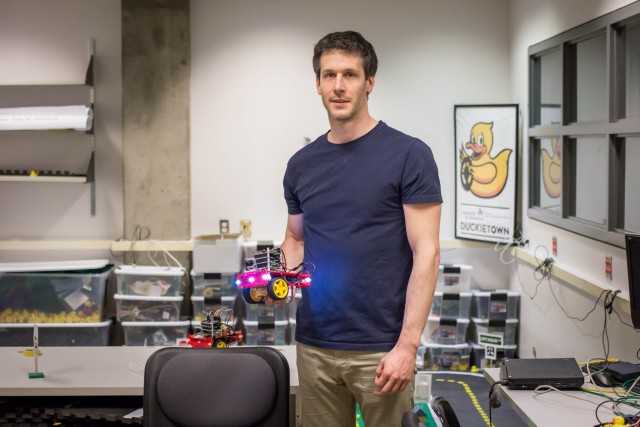
Good morning, Liam.
Hello.
Thank you very much for accepting to have this little chat.
Could you tell us something about you?
Sure. So my name is Liam Paull. I’m a professor at the University of Montreal in Quebec, Canada. I teach in the computer science Department, And I do research on robotics.
Ok and when was the first time you “came across” Duckietown?
Well, I’m actually one of the creators of Duckietown, So I didn’t come across it as much! The origin story of Duckietown is kind of interesting, But I probably forgot some of the details. It must have been about 2015. And myself, Andrea Censi, and a few others were interested to get more teaching experience. We were all postdocs or research scientists at MIT at the time. I guess we started brainstorming ideas, and then roughly around that time, I switched positions at MIT. I was previously a postdoc in John Leonard’s group working on marine robotics, and then I switched to become part of Danielle Lerous lab and lead an autonomous driving project. And so somehow the stars just aligned. That the right topic for this class that we would teach would be autonomous driving. Yeah, the Ducky thing is kind of a separate thing. Actually, Andrea had started this other thing that was making videos for people to publicize their work at a top robotics conference Called the international conference robotics automation, and somehow had the idea that every single video that was submitted should have a rubber Ducky in it. And this was for scale or something.
There was some kind of reason behind it I sort of forget. But anyway, so the branding kind of caught fire.
When we were building the class, we agreed the one constraint was that there should be duckies involved somehow, and the rest is kind of history!
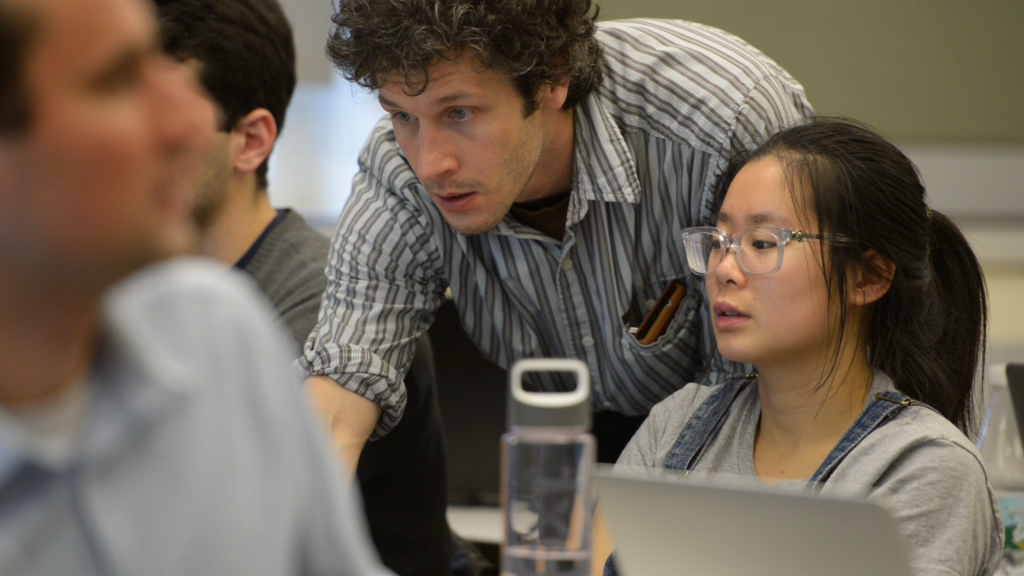
"I believe that there's a lot of interesting research directions that come from a standardized, small scale, accessible autonomous driving platform like Duckietown."
Liam Paull
Anything else you would like to add about Duckietown and it’s uses?
I didn’t mention specifically about the MOOC. One of the core missions of this project from the onset has been that it’s accessible. Both in terms of hardware but also in terms of software. And part of what that means to us Is that no matter where you are, no matter who you are, you should be able to get the hardware and you should be able to use the educational resources to learn. And part of the motivation for that Was that we saw that while we were at MIT. When you’re at a place like MIT you are extremely privileged and if you come from a background of less privilege, you see the discrepancy. In some sense, it’s palpable. Part of that, I guess, was that we don’t even necessarily want it to be a prerequisite that students should be enrolled in universities in order to be able to address the platform. So we built this massive online open source course through edx, which is also an open source provider Where people can, regardless of their background or regardless of their situation, they can sign up for this thing, and it’s a creative set of materials that also have exercises to interact with the robot that anybody can do, Regardless of whether they’re at a University or not.
I think this is the next step for us in making the platform accessible to all, and we’re going to continue to run iterations of this thing. But I also think that this is an exciting objective that very much fits in the mission of what we’re trying to do with this project.
This was great thank you for your time!
Awesome. Great. Thank you for your time. Bye.
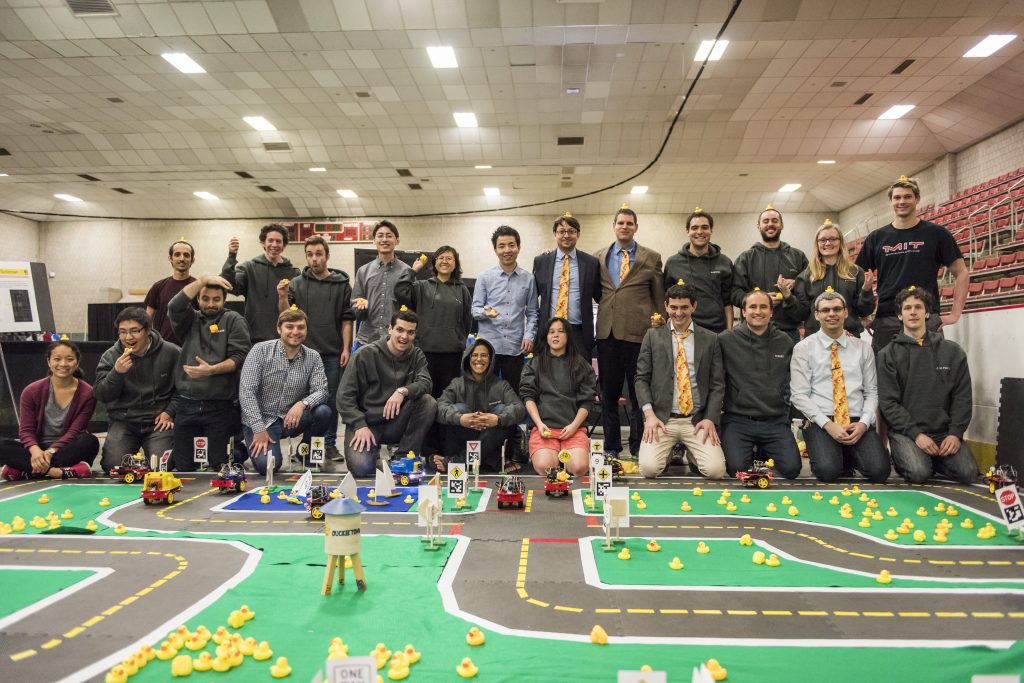
Learn more about Duckietown
The Duckietown platform offers robotics and AI learning experiences.
Duckietown is modular, customizable and state-of-the-art. It is designed to teach, learn, and do research: from exploring the fundamentals of computer science and automation to pushing the boundaries of knowledge.
Tell us your story
Are you an instructor, learner, researcher or professional with a Duckietown story to tell? Reach out to us!

Monocular Robot Navigation with Self-Supervised Pretrained Vision Transformers
Monocular Robot Navigation with Self-Supervised Pre-trained Vision Transformers
Duckietown’s infrastructure is used by researchers worldwide to push the boundaries of knowledge. Of the many outstanding works published, today we’d like to highlight “Monocular Robot Navigation with Self-Supervised Pretrained Vision Transformers” by Saavedra-Ruiz et al. at the University of Montreal.
Using visual transformers (ViT) for understanding their surroundings, Duckiebots are made capable of detecting and avoiding obstacles, while safely driving inside lanes. ViT is an emerging machine vision technique that has its root in Natural Language Processing (NLP) applications. The use of this architecture is recent and promising in Computer Vision. Enjoy the read and don’t forget to reproduce these results on your Duckiebots!
Abstract
“In this work, we consider the problem of learning a perception model for monocular robot navigation using few annotated images. Using a Vision Transformer (ViT) pretrained with a label-free self-supervised method, we successfully train a coarse image segmentation model for the Duckietown environment using 70 training images. Our model performs coarse image segmentation at the 8×8 patch level, and the inference resolution can be adjusted to balance prediction granularity and real-time perception constraints. We study how best to adapt a ViT to our task and environment, and find that some lightweight architectures can yield good single-image segmentations at a usable frame rate, even on CPU. The resulting perception model is used as the backbone for a simple yet robust visual servoing agent, which we deploy on a differential drive mobile robot to perform two tasks: lane following and obstacle avoidance.”
Pipeline
“We propose to train a classifier to predict labels for every 8×8 patch in an image. Our classifier is a fully-connected network which we apply over ViT patch encodings to predict a coarse segmentation mask:”
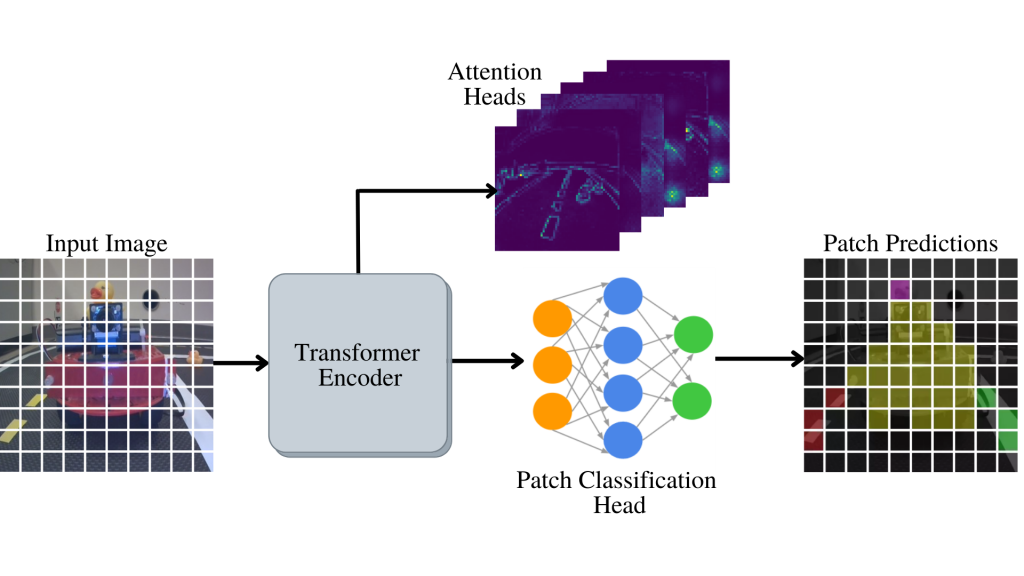
Conclusions
Learn more
The Duckietown platform offers robotics and AI learning experiences.
Duckietown is modular, customizable and state-of-the-art. It is designed to teach, learn, and do research: from exploring the fundamentals of computer science and automation to pushing the boundaries of knowledge.
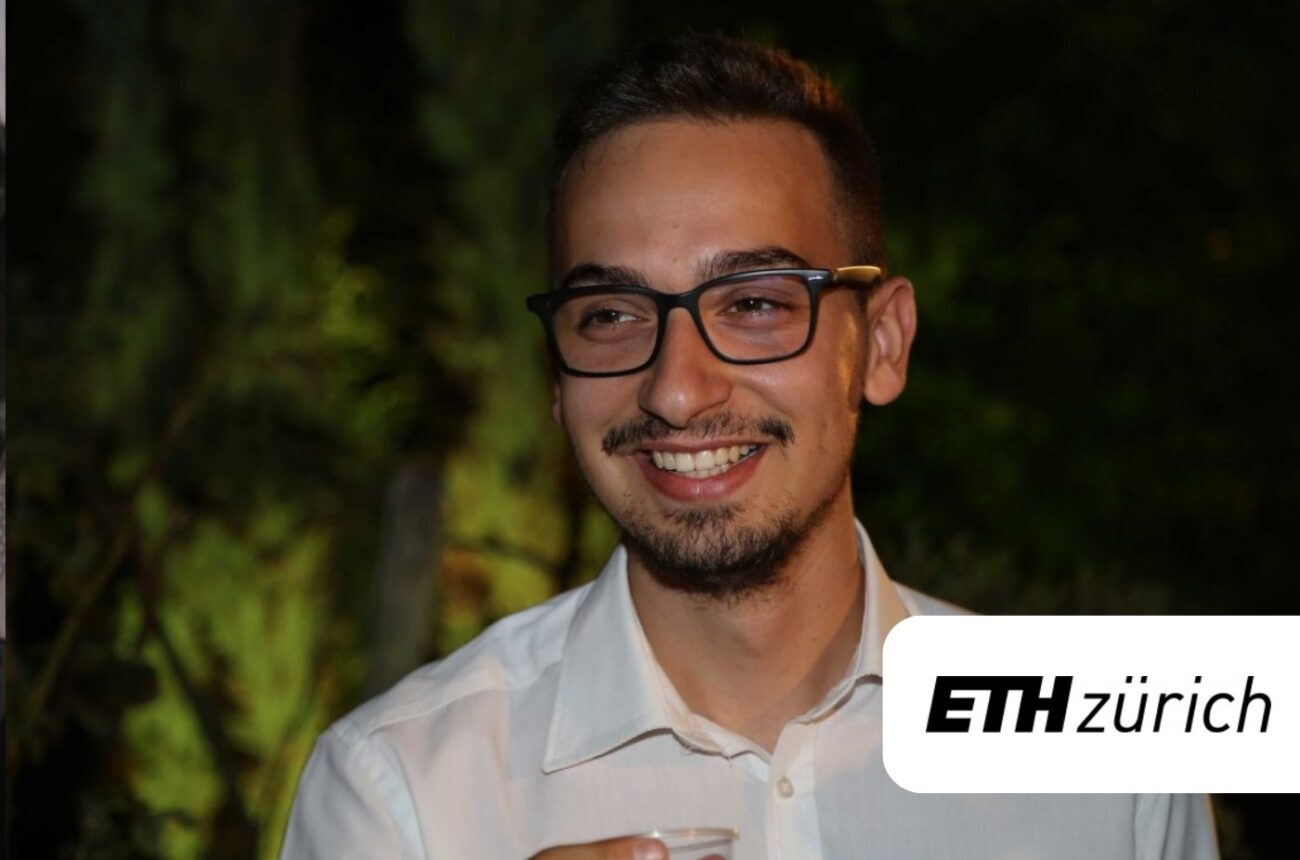
Learning Autonomy with Vincenzo Polizzi
ETHZ, Zurich, March 11, 2022: How Vincenzo discovered his true professional passion as a student using Duckietown.
Learning Autonomy in practice with Vincenzo Polizzi
Vincenzo Polizzi studied robotics, systems and control at the Swiss Federal institute of Technology (ETH Zurich). Vincenzo shares below his experience with Duckietown. Starting off as a student, becoming a Teaching Assistant and onto how he uses Duckietown to power his own research as he moves from academia to industry.
Quick links
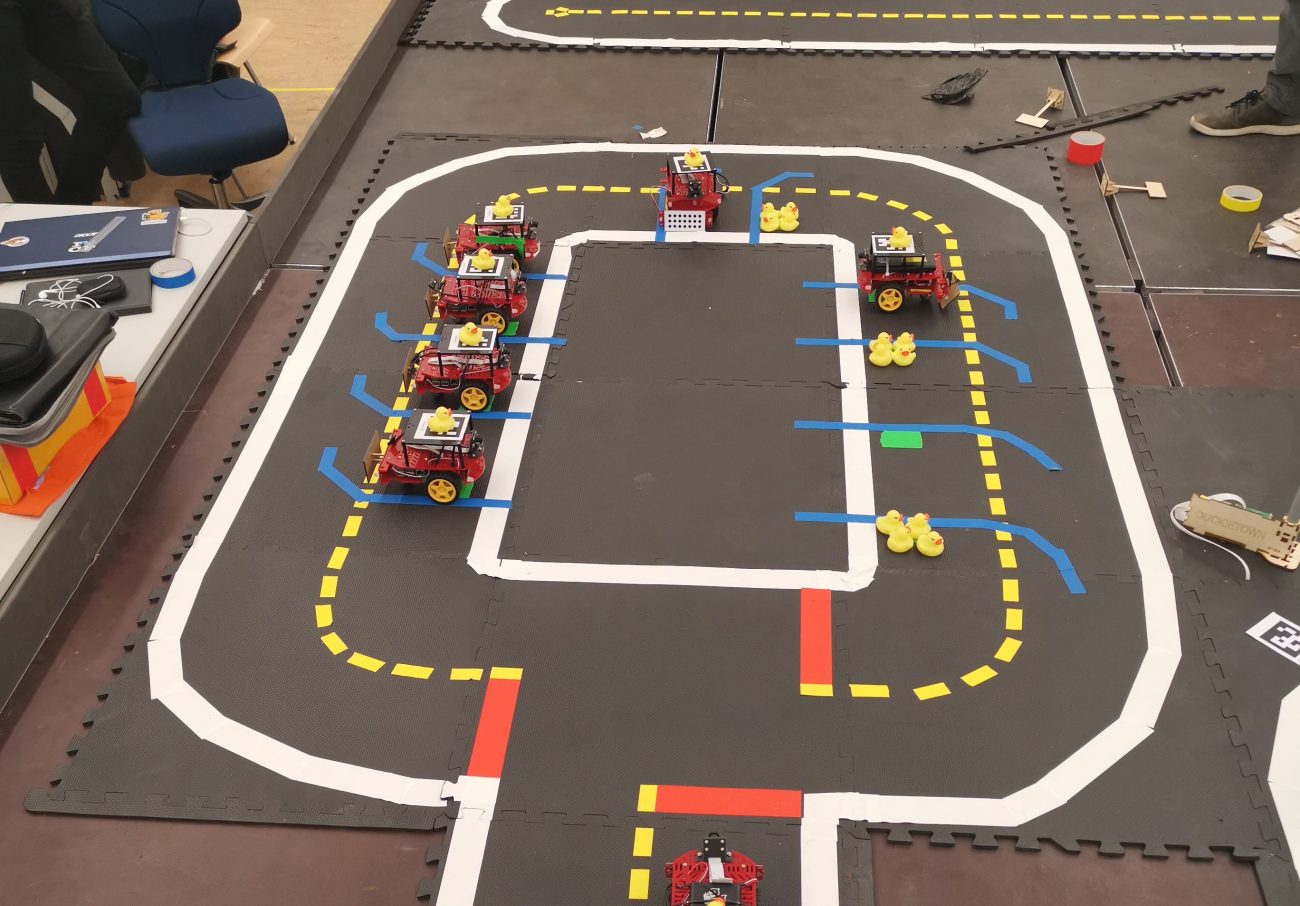
Could you tell us something about yourself?
I’m Vincenzo Polizzi , I studied automation engineering at the Politecnico di Milano, and I currently study robotics, systems and control at the Swiss Federal Institute of Technology (ETH Zurich).
You use Duckietown. Could you tell us when you first came into contact with the project, and what attracted you to Duckietown?
Sure! I learned about Duckietown my first year during a master’s program at ETH, where there was a course called: “Autonomous mobility on demand, from car to fleet” where I saw these cars, these robots. And I asked myself “what is this thing?”. It seemed very interesting. The first thing that struck me was that it did not look theoretical, but clearly practical.
"It captures you with simplicity and then you stay for the complexity."
Vincenzo Polizzi
So the idea of a practical aspect interested you?
Yes, during the presentation, it was clear that the course was based on projects the student had to carry out, where one could practice what they had learned theoretically in other classes.
I come from a scientific high school, and I studied automation engineering in Milan. In both my study experiences, I was used to learning concepts theoretically. For example, in the control system for a plant you design on paper in university, you don’t really face the complexity of implementing it on a real object.
I have to say that I have always been very passionate about robotics and informatics. In fact, even in high school, I was building these little robots,I participated in the robotics competition Rome Cup held by Fondazione Mondo Digitale, and there were these robots that were similar in shape to those of Duckietown, but where the scientific content was completely different. So in Duckietown, I saw something similar to what I was doing in my free time. I wanted to see exactly how it was inside, and there I discovered a whole other world that is obviously much more scientific than what a normal high school student could imagine by themself. However, initially I was curious to see a course where one can practice all the knowledge they have gradually acquired. It is not just about writing an equation and finding a solution but making things work.

What is your relationship with Duckietown, how long have you been using it? How do you interact with the Duckietown ecosystem? How do you use it, what do you do with it?
These are interesting questions because I started as a student and then managed to see what’s behind Duckietown. I was attending the course Duckietown held at ETH in 2019. The class was limited to 30 students, I was really excited to be part of it. I met many excellent students there, some of whom I am still in touch with today.
When I started the course, I immediately told myself, “Duckietown is a great thing. If all universities used Duckietown, this would be a better world.” I liked the class a lot, then I also had the opportunity of being a TA. The TAship was an important step because I learned more than during the course. One thing is to live the experience as a student who has to take exams, complete various projects, etc. You need a deeper understanding to organize an activity. You have to take care of all the details and foresee the parts of the exercise that can be harder or simpler for the students. This experience helped me a lot. For example, I did an internship in Zurich where we had to develop a software infrastructure for a drone, and I found myself thinking, “wow this can be done with Duckietown, we can use the same technologies.” I noticed that even in the industry, often we see the use of the same technologies and tools that you can learn about thanks to Duckietown. Of course, maybe a company has its own customized tools, probably well optimized for its products. Perhaps it uses some other specific tool but let’s say you already know more or less what these tools are about. You know because in Duckietown, you have already seen how a robotics system should work and the pieces it is composed of. Duckietown has given me a huge boost with the internship and my Master’s thesis at NASA JPL. Consider that my thesis was on a system of multi drones, so I used, for example, Docker as a tool to simulate the different agents. With Duckietown, I acquired technical knowledge that I used in many other projects, including work.
Do you still use it today?
The last project I did with Duckietown is DuckVision. I know we could have thought of a better name. With one of my Duckietowner friends, Trevor Phillips, we enhanced the Duckiebot perception pipeline with another camera, a stereocamera made by Luxonis and Open CV called OAKD (OpenCV AI Kit with depth). This sensor is not just a simple camera, but it also mounts a VPU, Visual Processing Unit. Namely, it can analyze and make inferences on the images that the camera acquires onboard. It can perform object detection and tracking, gesture recognition, semantic segmentation, etc. There are plenty of models freely available online that can run on the OAK-D. We have integrated this sensor in the Duckietown ecosystem, using a similar approach used in the MOOC “Self-Driving Cars with Duckietown”, we created a small series of tutorials where you can just plug the camera on the robot, run our Docker container and have fun! With this project, we passed the first phase of the OpenCV AI Competition 2021. The idea behind the project was to increase the Duckiebot understanding of the environment, by using the depth information, the robot can have a better representation of its surroundings and so, for example, a better knowledge of its position. Also, in our opinion, the OAK-D in Duckietown can boost the research in autonomous vehicles and perception.
I would like to add something about the use of Duckietown, I have seen this project both as a student and from behind the scenes and I really understood that by using this platform you really learn a lot of things that are useful not only in the academic field but can also be very useful in the working environment with the practical knowledge that is often difficult to acquire during school. And in this regard I thought then given my history, I am Sicilian but I studied in Milan and then I went to Zurich, I asked myself what can I bring as a contribution of my travels, so I thought about using Duckietown in some universities here in Sicily in the universities of Palermo and Messina. And also, at the Polytechnic of Milan, for example, they have already begun to use it and have participated in the AIDO and have also placed well, they ended up among the finalists, so there is a lot of interest in this project.
Did you receive a positive response every time you proposed Duckietown?
Yes, and then there is a huge enthusiasm on the part of the students. I spoke with student associations first, then with the professors etc. but when the students see Duckietown for the first time, they are always really enthusiastic about using it.
"There is something that captures you in some way, and then just opens up a world when you start to actually see how all the systems are implemented. This is the nice thing in my opinion, you can decide the level of complexity you want to achieve."
Vincenzo Polizzi
The duck was a great idea!
Absolutely right! The duck was a great idea, yes. I like contrasts, you see a super simple friendly thing that hides a state-of-the-art robotics platform. Even in the students I saw this reaction, because the duck is the first thing you see, it looks like a game, something to play with, this is the first impact, then when you start you get curious. It captures you with simplicity and then you stay for the complexity.
Would you suggest Duckietown to friends and colleagues?
Sure! There is something that captures you and opens up a world when you start to see how all the systems are implemented. This is the nice thing in my opinion, you can decide the level of complexity you want to achieve. It’s a platform that looks like something to play with, a game or something, but in reality there is a huge potential, in terms of knowledge that everyone can acquire, it’s something that you can not easily find elsewhere. I also think it offers great support, such as educational material, exercises that are of high quality. You can learn a lot of different aspects of robotics, in my opinion. You can do control, you can do the machine learning part, perception . There’s really a world to explore. You can see everything there is about robotics. But you can also just focus on one aspect that maybe you’re more passionate about. So yes, I would recommend it because you can learn a lot, and as a student myself I would recommend it to my fellow colleagues.
Learn more about Duckietown
The Duckietown platform offers robotics and AI learning experiences.
Duckietown is modular, customizable and state-of-the-art. It is designed to teach, learn, and do research: from exploring the fundamentals of computer science and automation to pushing the boundaries of knowledge.
Tell us your story
Are you an instructor, learner, researcher or professional with a Duckietown story to tell? Reach out to us!

AI Driving Olympics 2021: Urban League Finalists
AI Driving Olympics 2021 - Urban League Finalists
LF), lane following with vehicles (LFV) and lane following with intersections, (LFI).
To account for differences between the real world and simulation, this edition finalists can make one additional submission to the real challenges to improve their scores.
Finalists are the authors of AI-DO 2021 submissions in the top 5 ranks for each challenge.
This year’s finalists are: LF
- András Kalapos
- Bence Haromi
- Sampsa Ranta
- ETU-JBR Team
- Giulio Vaccari
LFV
- Sampsa Ranta
- Adrian Brucker
- Andras Beres
- David Bardos
LFI
- András Kalapos
- Sampsa Ranta
- Adrian Brucker
- Andras Beres
The deadline for submitting the “final” submissions is Dec. 9th, 2 pm CET. All submissions received after this time will count towards the next edition of AI-DO.
Don’t forget to join the #aido channel on the Duckietown Slack for updates!
Congratulations to all the participants, and best of luck to the finalists!
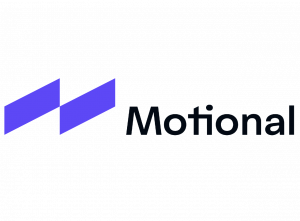


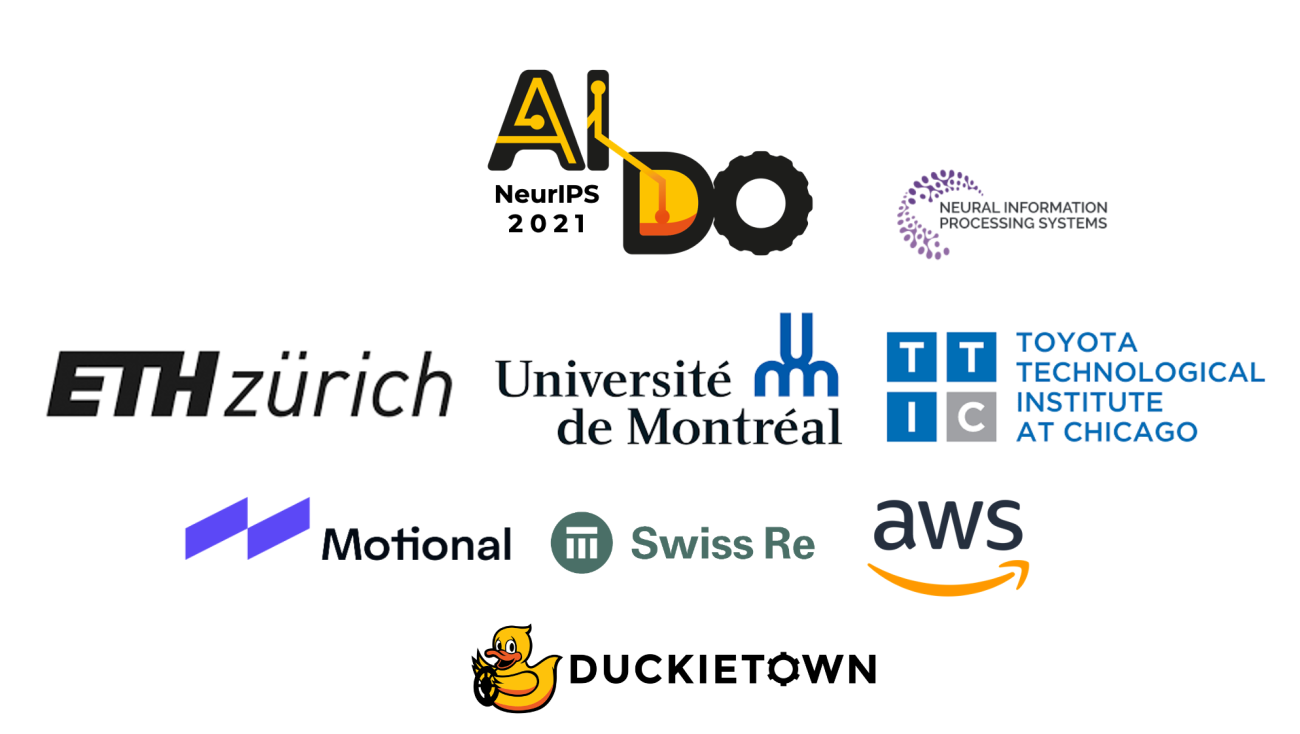
Join the AI Driving Olympics, 6th edition, starting now!
The 2021 AI Driving Olympics
Compete in the 2021 edition of the Artificial Intelligence Driving Olympics (AI-DO 6)!
The AI-DO serves to benchmark the state of the art of artificial intelligence in autonomous driving by providing standardized simulation and hardware environments for tasks related to multi-sensory perception and embodied AI.
Duckietown traditionally hosts AI-DO competitions biannually, with finals events held at machine learning and robotics conferences such as the International Conference on Robotics and Automation (ICRA) and the Neural Information Processing Systems (NeurIPS).
AI-DO 6 will be in conjunction with NeurIPS 2021 and have three leagues: urban driving, advanced perception, and racing. The winter champions will be announced during NeurIPS 2021, on December 10, 2021!
Urban driving league
The urban driving league uses the Duckietown platform and presents several challenges, each of increasing complexity.
The goal in each challenge is to develop a robotic agent for driving Duckiebots “well”. Baseline implementations are provided to test different approaches. There are no constraints on how your agents are designed.
Each challenge adds a layer of complexity: intersections, other vehicles, pedestrians, etc. You can check out the existing challenges on the Duckietown challenges server.
AI-DO 2021 features four challenges: lane following (LF), lane following with intersections (LFI), lane following with vehicles (LFV) and lane following with vehicles and intersections, multi-body, with full information (LFVI-multi-full).
All challenges have a simulation and hardware component (

LFVI-multi-full, which is simulation (
The first phase (until Nov. 7) is a practice one. Results do not count towards leaderboards.
The second phase (Nov. 8-30) is the live competition and results count towards official leaderboards.
Selected submissions (that perform well enough in simulation) will be evaluated on hardware in Autolabs. The submissions scoring best in Autolabs will access the finals.
During the finals (Dec. 1-8) one additional submission is possible for each finalist, per challenge.
Winners (top 3) of the resulting leaderboard will be declared AI-DO 2021 winter champions and celebrated live during NeurIPS 2021. We require champions to submit a short video (2 mins) introducing themselves and describing their submission.
Winners are invited to join (not mandatory) the NeurIPS event, on December 10th, 2021, starting at 11.25 GMT (Zoom link will follow).
Overview
| 🎯 | Goal: develop robotic agents for challenges of increasing complexity |
| 🚙 | Robot: Duckiebot (DB21M/J) |
| 👀 | Sensors: camera, wheel encoders |
Schedule
 | Practice: Nov. 1-7 |
 | Competition: Nov. 8-30 |
 | Finals: Dec. 1 – 8 |
 | Winners: Dec. 10 |
Rules
 | Practice: unlimited non-competing submissions |
 | Competition: best in sim are evaluated on hardware in Autolabs |
 | Finals: one additional submission for Autolabs |
 | Winners: 2 mins video submission description for NeurIPS 2021 event. |
The challenges
Lane following 

LF – The most traditional of AI-DO challenges: have a Duckiebot navigate a road loop without intersection, pedestrians (duckies) nor other vehicles. The objective is to travel the longest path in a given time while staying in the lane, i.e., not committing driving infractions.
Current AI-DO leaderboards: LF-sim-validation, LF-sim-testing.
Previous AI-DO leaderboards: sim-validation, sim-testing, real-validation.
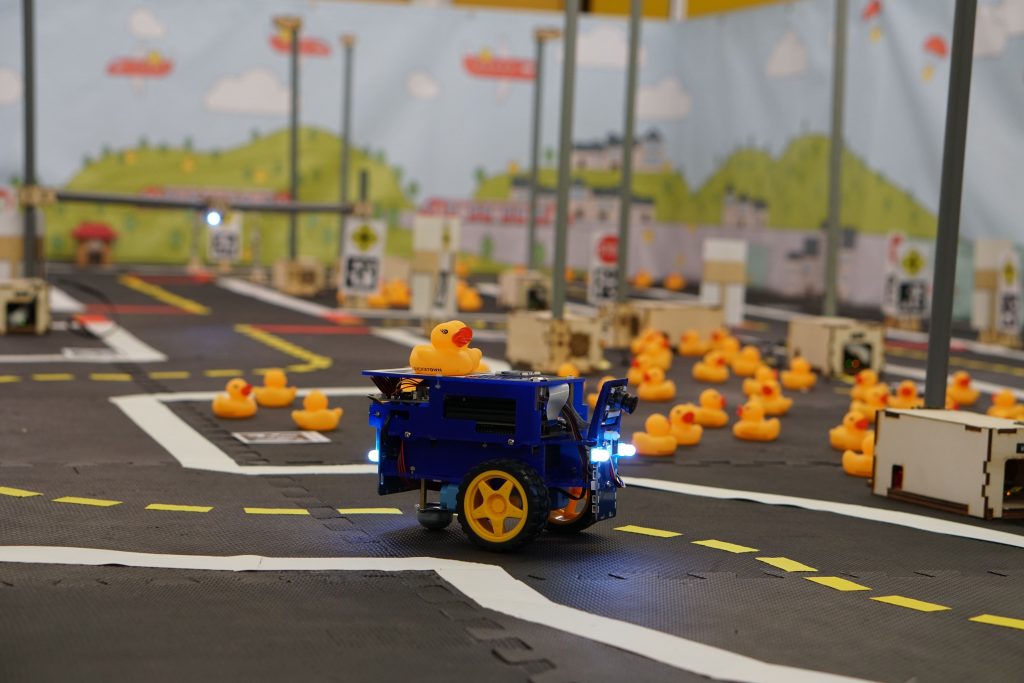
Lane following with intersections 

LFI – This challenge builds upon LF by increasing the complexity of the road network, now featuring 3 and/or 4-way intersections, defined according to the Duckietown appearance specifications. Traffic lights will not be present on the map. The objective is to drive the longest distance while not breaking the rules of the road, now more complex due to the presence of traffic signs.
Current AI-DO leaderboards: LFI-sim-validation, LFI-sim-testing.
Previous AI-DO leaderboards: sim-validation, sim-testing.
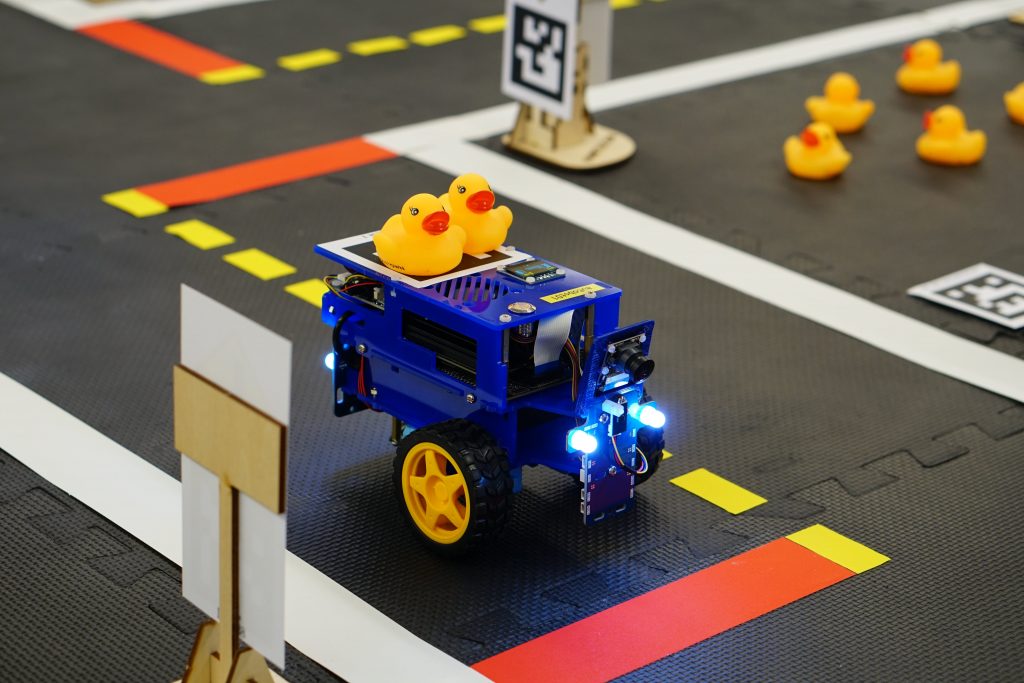
Lane following with vehicles 

LFV – In this traditional AI-DO challenge, contestants seek to travel the longest path in a city without intersections nor pedestrians, but with other vehicles on the road. Non-playing vehicles (i.e., not running the user’s submitted agent) can be in the same and/or opposite lanes and have variable speed. Current AI-DO leaderboards: LFV-sim-validation, LFV-sim-testing.

Lane following with vehicles and intersections (stateful) 
LFVI-multi-full – this debuting challenge brings together roads with intersections and other vehicles. The submitted agent is deployed on all Duckiebots on the map (-multi), and is provided with full information, i.e., the state of the other vehicles on the map (-full). This challenge is in simulation only. Leaderboards: LFVI_multi_full-sim-validation
Getting started
All you need to get started and participate in the AI-DO is a computer, a good internet connection, and the ambition to challenge your skills against the international community!
We provide webinars, operation manuals, and baselines to get started.
May the duck be with you!
Thank you to our generous sponsors!

Automatic Wheels and Camera Calibration for Monocular and Differential Mobile Robots
- Automatic Wheels and Camera Calibration for Monocular and Differential Mobile Robots
- Konstantin Chaika, Anton Filatov, Artyom Filatov, Kirill Krinkin
- Applied Sciences 11, no. 13: 5806.
Automatic Wheels and Camera Calibration for Monocular and Differential Mobile Robots
After assembling the robot, components such as the camera and wheels need to be calibrated. This requires human participation and depends on human factors. We describe the approach to fully automatic calibration of a robot’s camera and wheels.
The camera calibration collects the necessary set of images by automatically moving the robot in front of the chess boards, and then moving it on the marked floor, assessing its trajectory curvature. As a result of the calibration, coefficient k is calculated for the wheels, and camera matrix K (which includes the focal length, the optical center, and the skew coefficient) and distortion coefficients D are calculated for the camera.
Proposed approach has been tested on duckiebots in Alexander Popov’s International Innovation Institute for Artificial Intelligence, Cybersecurity and Communication, SPbETU “LETI”. This solution is comparable to manual calibrations and is capable of replacing a human for this task.
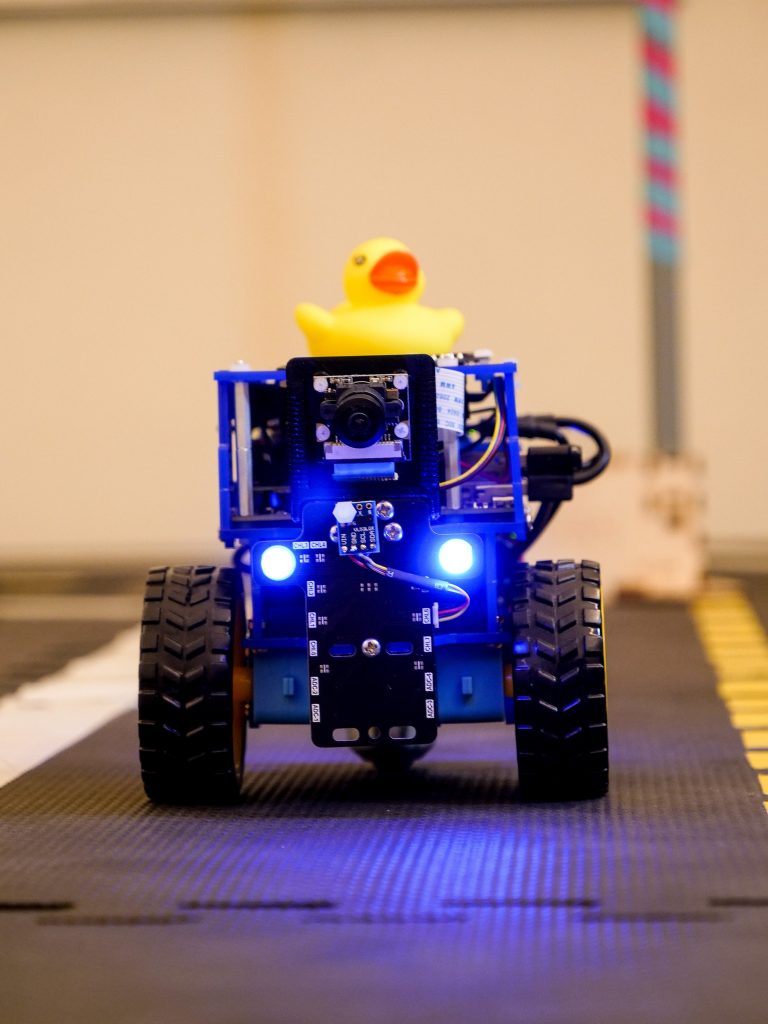
Camera calibration process
The initial position of the robot is a part of the floor with chessboards in front, where the robot is located from the very beginning, on which its camera is directed and the floorsurface is marked with aruco markers on the other side of it.
There can be any number of chessboards, determined by the amount of free space around the robot. To a greater extent, the accuracy of calibration is affected by the frames with different positions of the boards, e.g., boards located at different distances from the robot and at different angles. The physical size and type of all the boards around the robot must be the same.
In fact, the camera calibration implies that the robot is rotating around its axis and taking pictures of all the viewable chessboards in turn. In this case, the ability to make several “passes” during the shooting process should be provided for, to control which of the boards the robot is currently observing and in which direction it should turn. As a result, the algorithm can be represented as a sequence of actions: “get a frame from the camera” and “turn” a little. The final algorithm comprises the following sequence of actions:
- Obtain frame from the camera;
- Find a chessboard on the camera frame;
- Save information about board corners found in the image;
- Determine the direction of rotation according to the schedule;
- Make a step;
- Either repeat the steps described above, or complete the data
collection and proceed with the camera calibration using OpenCV.
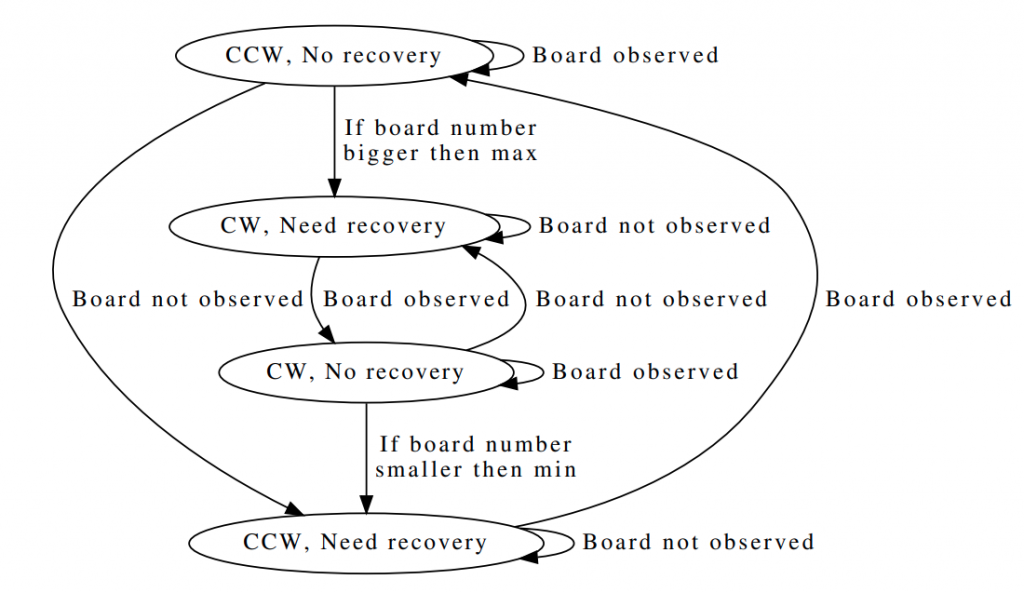
Wheels calibration process
Floor markers should be oriented towards the chessboards and begin as close to the robot as possible. The distance between the markers depends on camera’s resolution, as well as its height and angle of inclination, but it must be such that at least three recognizable markers can simultaneously be in the frame. For ours experiments, the distance between the markers was set as 15 cm with a marker size of 6.5 cm. The algorithm does not take into account the relative position of the markers against each other; however, the orientation of all markers must be strictly the same.
Let us consider the first iteration of the automatic wheel calibration algorithm:
- The robot receives the orientation of the marker closest to it and remembers it.
- Next, the robot moves forward with thespeeds of the left and right wheels equal to
ω1ω2 for some fixed time t. The speeds are calculated taking into account the calibration
coefficient k, which for the first iteration is chosen to equal 1 – that is, it is assumed that
the real wheel speeds are equal. - The robot obtains the orientation of the marker closest to it again and calculates the
difference in angles between them. - The coefficient ki for this step is calculated.
- The robot moves back for the same time t.
In order to reduce the influence of the error in calculating ki, coefficient k is refined only by the value of (ki−1)/2 after each iteration. It is important to complete this step after the robot moves back, because it reduces the chance of the robot moving outside the area width. If, after the next step, the modulus of the difference between (ki−1)/2 and 1.0 becomes less than the pre-selected E, then at this iteration (ki−1)/2 is not taken into account. If after three successive iterations ki is not taken into account, the wheel calibration is considered to be completed.

Accuracy Evaluation
To compare camera calibration errors, the knowledge of how to calculate these errors is needed. Since the calibration mechanism is used by the OpenCV library, the error is also calculated by the method offered by this library.
As noted earlier, with respect to calibration factors, the approach used to calibrate the camera is not applicable. Therefore, the influence of the coefficient on the robot’s trajectory curvature is estimated. To do this, the robot was located at a certain fixed distance from a straight line, along which it was oriented and then moved in manual mode strictly directly to a distance of two meters from the start point along the axis, relative to which it was oriented. Then, the robot stopped and the distance between the initial distance to the line and the final one was calculated.
Two metrices were estimated – reprojection error and straight line deviation. First one shows the quality of camera calibration, and the second one represents the quality of wheels calibration. Two pictures below present result of 10 independent tests in comparison with manual calibration.


The tests found that the suggested solution, on average, shows that the results are not much worse, than the classical manual solution when calibrating the camera, as well as when calibrating the wheels with a well known calibrated camera. However, when calibrating both the wheels and the camera, the wheel calibration can be significantly affected by the camera calibration effect. As a result of testing, a clear relationship was found between the reprojection error and the straight line deviation.
Method Modifications
After the integration of this approach, it became necessary to automate the last step-moving the robot to the field. Due to the fact that after the calibration step completion the robot becomes fully prepared for launching autonomous driving algorithms on it, the automation of this step further reduces the time spent by the operator when calibrating the robot, since instead of moving the robot to the field manually, he can place the next robot at the starting position. In our case, the calibration field was located at the side of the road lane so that the floor markers used to calibrate the wheels are oriented perpendicular to the road lane.
Thus, the first stage of the robot automatic removal from the calibration zone is to return its orientation back to the same state, as it was at the moment when the wheel calibration started. This was carried out using exactly the same approach that was described earlier—depending on the orientation of the floor marker closest to the robot, the robot rotates step by step about its axis clockwise or counterclockwise until the value of the robot’s orientation angle is modulo less than some preselected value.
At this point, the robot is still on the wheel calibration field, but in this case, it is oriented towards the lane. Thus, the last step is to move the robot outside the border of the field with markers. To do this, it is enough to give the robot a command to move directly until it stops observing the markers, when the last marker is hidden from the camera view. This means that the robot has left the calibration zone, and the robot can be put into the lane following mode.
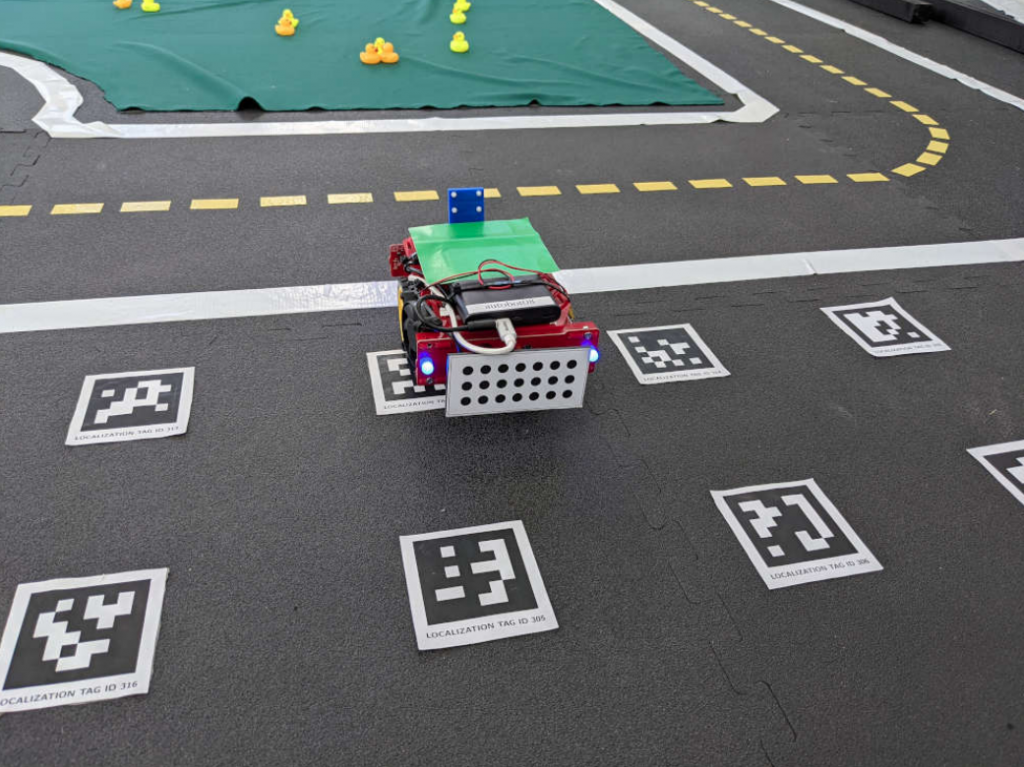
Future Work
During the robot’s operation, the wheels calibration may become irrelevant. It can be influenced by various factors: a change in the wheel diameter due to wear of the wheel coating, a slight change in the characteristics of motors due to the wear of the gearbox plastic, and a change in the robot’s weight distribution, e.g., laying the cables on the other side of the case after charging the robot, and so a slight calibration mismatch can occur. However, all these factors have a rather small impact, and the robot will still have a satisfactory calibration. There is no need to re-perform the calibration process, just a little refinement of the current one seems to be enough. To do this, a section of the road along which the robots will be guaranteed to pass regularly, was selected.
Further, markers were placed in this lane according to the rules described earlier: the distance between the markers is 15 cm; the size of the marker is 6.5 cm. The markers are located in the center of the lane. The distance between the markers may be not completely accurate, but they should be oriented in the same direction and co-directed with the movement in the lane on which they are placed.
The first marker in the direction of travel must have a predefined ID. It can be anything, the only limitation is that it must be unique for a current robot environment. Further, the following changes were made to the algorithm for the standard control of the robot: when the robot recognizes the first marker with a predetermined ID while driving right in the lane, it corrects its orientation relative to this marker and continues to move strictly straight ahead. Further, the algorithm is similar to the one described earlier—the robot recognizing the next marker can refine its wheel calibration coefficient, apply it, and change the orientation coaxially with the next marker.
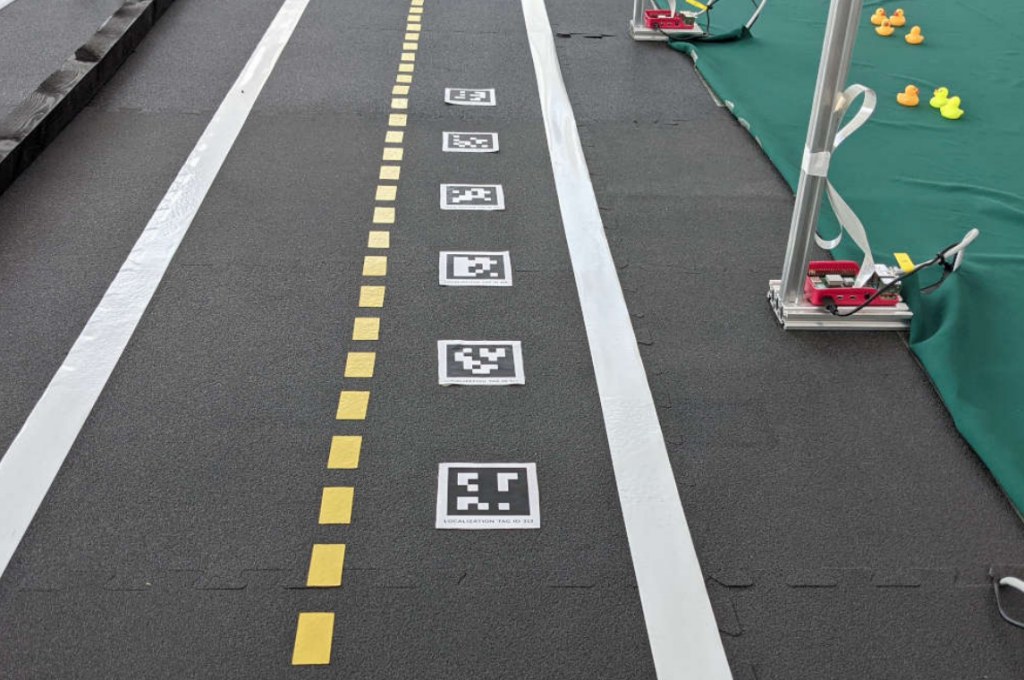
Conclusions
As a result, a solution was developed that allows a fully automatic calibration of the camera and the Duckiebot’s wheels. The main feature is the autonomy of the process, which allows one person to run the calibration of an arbitrary number of robots in parallel and not be blocked during their calibration. In addition, the robot is able to improve its calibration as it operates in default mode.
Comparing the developed solution with the initial one resulted in finding a slight deterioration in accuracy, which is primarily associated with the accuracy of the camera calibration; however, the result obtained is sufficient for the robot’s initial calibration and is comparable to manual calibration.
Did you find this interesting?
Read more Duckietown based papers here.

